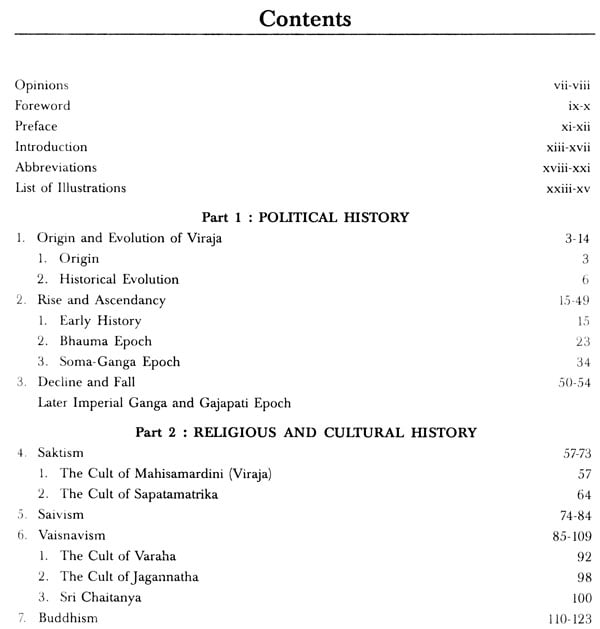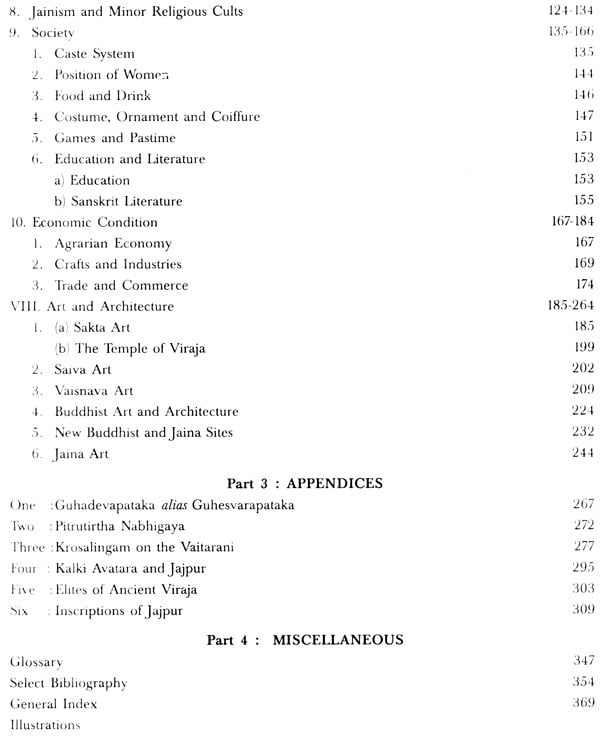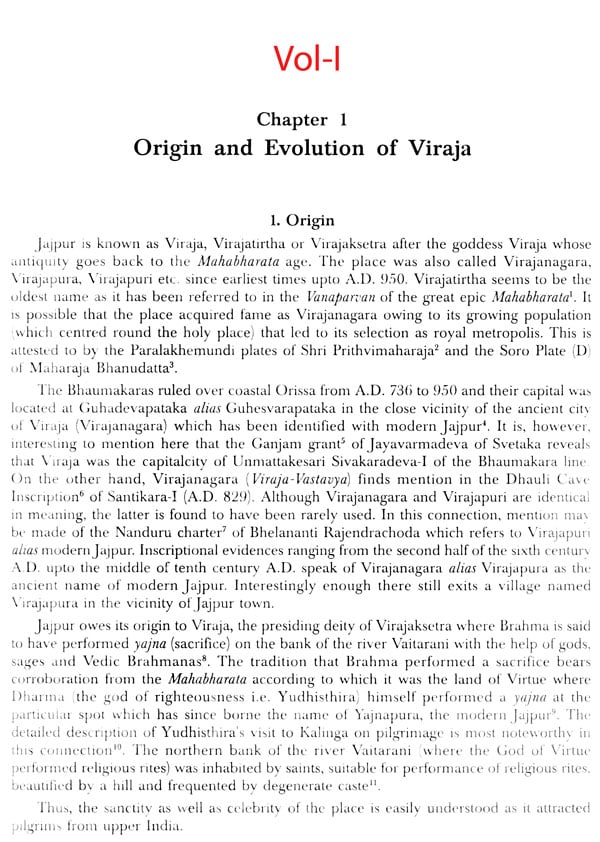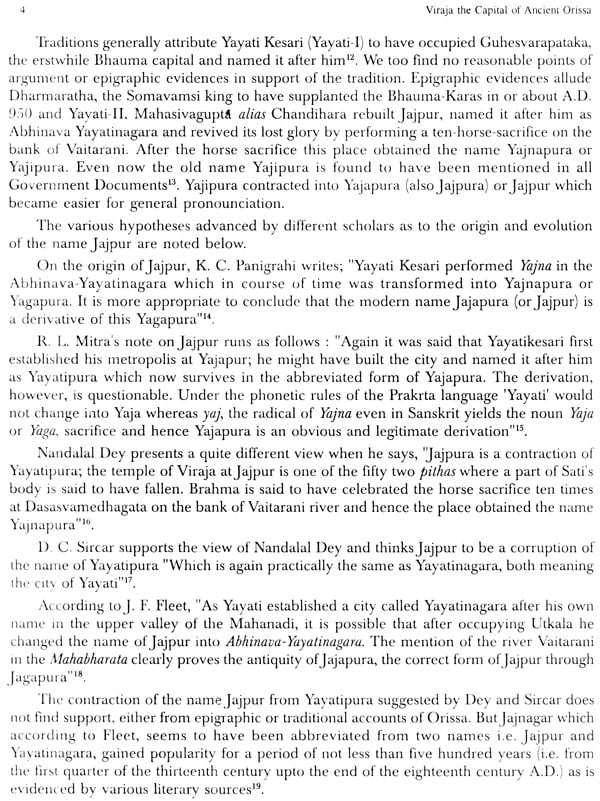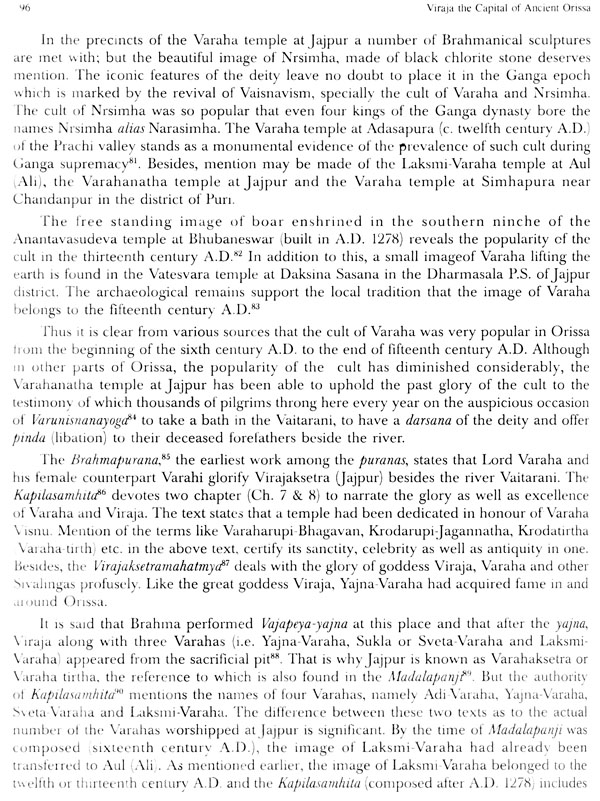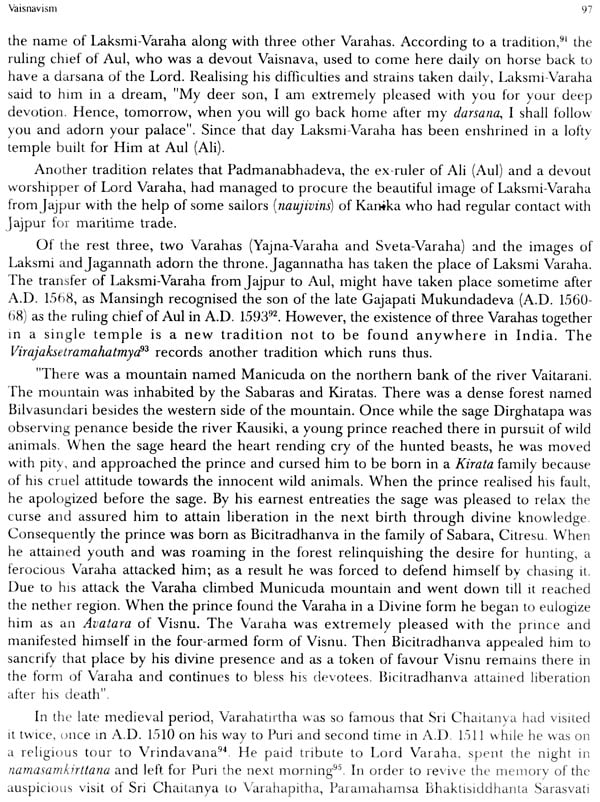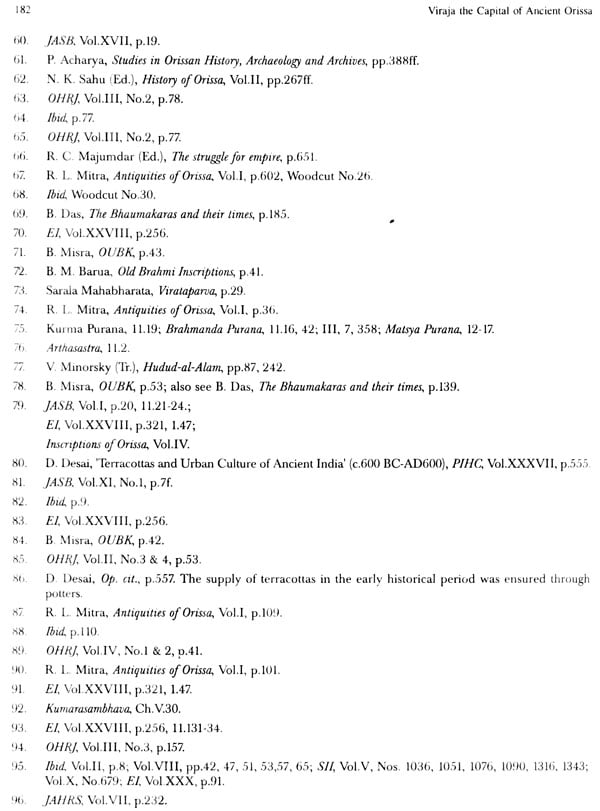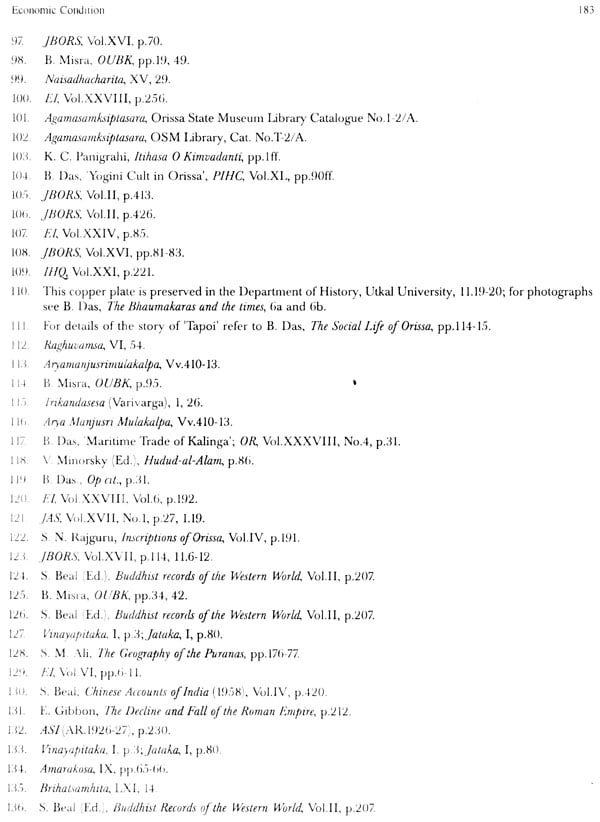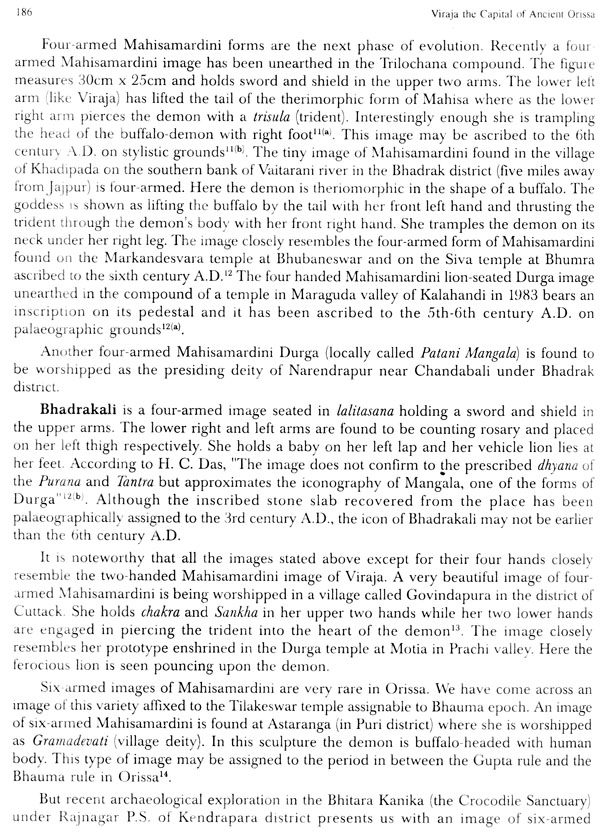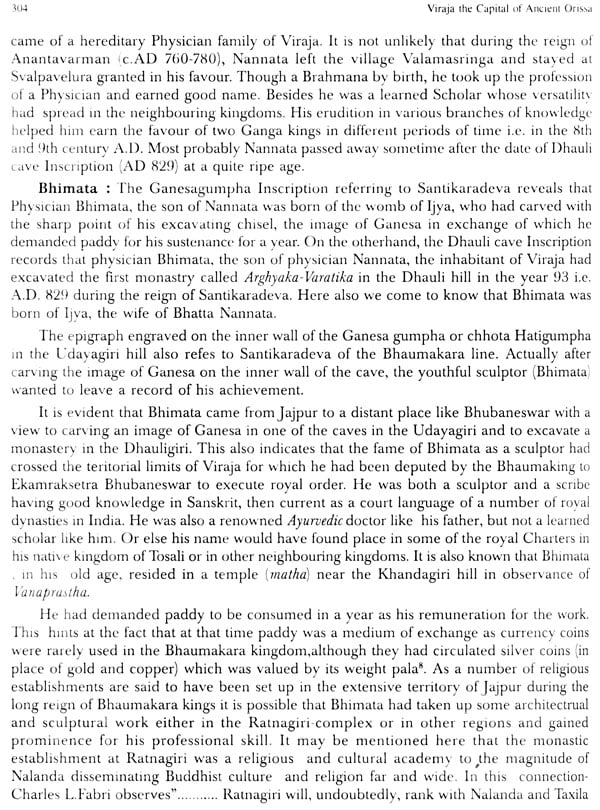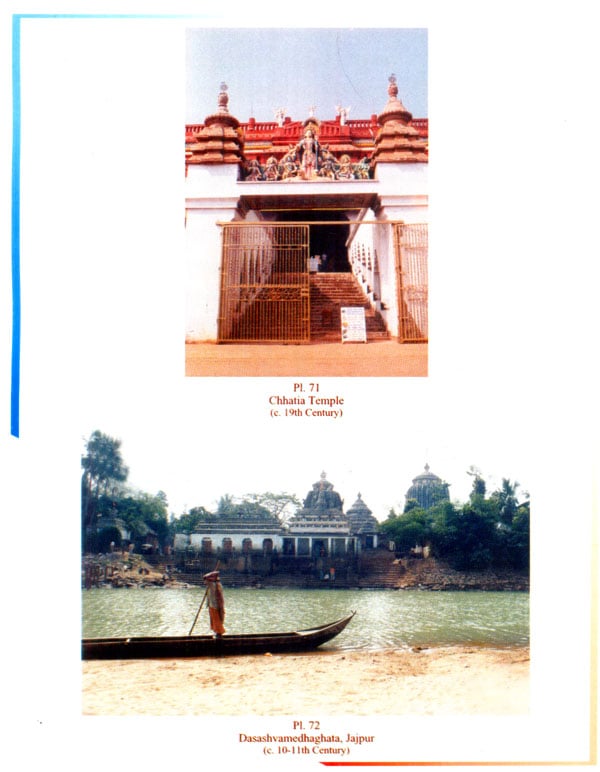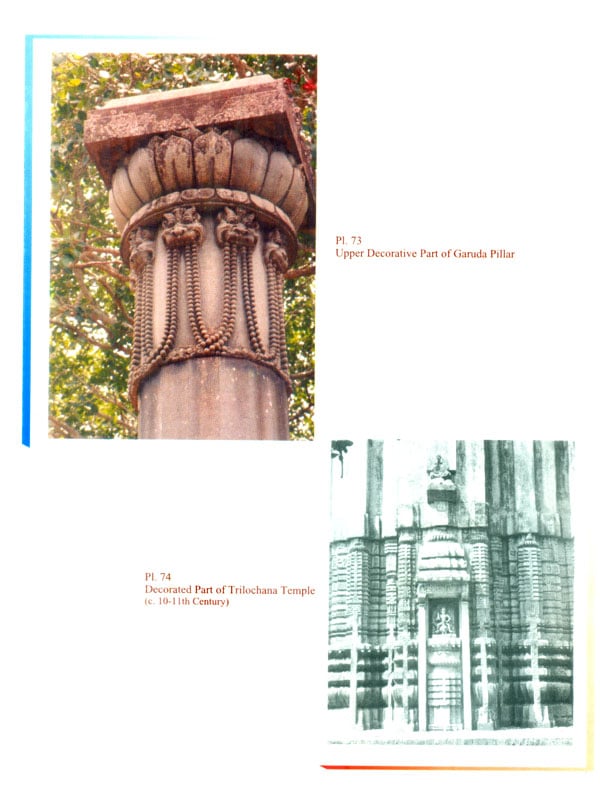
Viraja - The Capital of Ancient Orissa (Set of 2 Volumes)
Book Specification
| Item Code: | NAY673 |
| Author: | S.P. Mishra |
| Publisher: | Pratibha Prakashan |
| Language: | English |
| Edition: | 2007 |
| ISBN: | 8177021486 |
| Pages: | 456 |
| Cover: | HARDCOVER |
| Other Details | 11.00 X 8.50 inch |
| Weight | 1.80 kg |
Book Description
It is pertinent to mention here that Jamnagar Odisha could hold the banner of Orissa's independence high when all the Hindu states of India had already succumbed to the Muslim arms (by the end of 12th century A.D.).
The book presents critical judgment objectivity, extensive field work, mastery over source materials and adherence to historical accuracy. With its globally renowned poetry, art, architecture, religious efflorescence, sculpture and still indeed, a center of such creative art as the making of fine jeweler. Jaipur has been a Mecca for the travelers who wish to undergo a rich creative experience.
Not only Sikhism Saivism and Vaisnavism but also Buddhism and Jainism flourished in this sacred soil, reflection of which is visualized in the art and archaeological objects.
In view of all above points, the book will certainly prove to be an indispensable source of reference to the scholars and students interested in Orissa and Indian History.
Dr. Mishra worked as an Executive in the Education Department under SAIL, RMD, BIM. He has authored a number of books on Mantra, Yantra and Tantra including Chromo therapy the ancient most method of treating diseases by sun-rays. He has taken up Naturopathy as a hobby since 1985 and published three monographs (both in Oriya and English) on Chromopathy of which "Miracles of Color 17zerapy"published by the Firma KLM, Calcutta has earned wide celebrity and popularity since its publication in the year 1995. His other two works 'Anubhuta Suryakirana Chikitsa'(1987) and 'Abhinaoa Saura Chikitsa' (1996) has undergone two editions and awaits their third impression.
At present the author is engaged inexpensive research work undertaken by the "State Level Vyasakavi Fakirmohan Smruti Samsad", Bhubaneswar. The Institute has brought out seven volumes of Cultural Heritage of Orissa out of the targeted 30 volumes comprising 30 modem districts of Orissa.
Jajpur however, was not exclusively a Sakta centre. In course of time Buddhism, Jainism, Saivism and Vaisnavism developed in that area of which archaeological remains are still visible. In 1815, the colossal matrika images of Jaipur attracted the attention of the Surveyor-general, Colonel Collin Mackenzie who prepared their drawing through his artists. Probably the largest Avalokitesvara image is to be found in Jaipur which is now preserved in the premises of Sub-Collector's residence. The earliest Vishnu images discovered from Jajpur date back to about 7th century A.D. The huge Suhhastambha (Garuda pillar) and the detached Garuda figure also indicate the popularity of Vishnu worship in this Sakta centre. The Jaina images are to be found in various places of Jaipur and most probably the largest Tirthankara figure is to be found at Hatadiha in the neighborhood of Jajpur.
Jaipur is also distinguished by its Siva temples such as Trilochanesvara, Akhandalesvara, Siddhesvara and others. According to the Virajaksetramahatmya the Sakta centre. of Jajpur was triangular in layout and it is interesting to note that some of the Sivalingas are also star-shaped in form indicating their Tantric character.
Apart from being a religious centre, Jajpur in the past seems to have been the centre of political activities. The capital of Bhaumakara ruling dynasty located in the vicinity of Viraja was known as Guhadevapataka alias Guhesvarapataka. It may be mentioned that out of the eighteen-rulers of the Bhaumkara family, one third of them were women which is an important feature in the political history of Orissa. It is contrary to the injunctions of Manu who is against granting political rights to women. Some of the early rulers of the Bhaumkara line were Buddhists and they patronized Buddhism and even at present Buddhist centers like Ratnagiri, Udayagiri, Vajragiri, Languid hill, Solampur, Khadipada, Mangalapur etc. are to be found in the neighborhood of J ipur. Some of the Buddhist kings of Bhaumakara family seem to have maintained cultural contact with the rulers of China which indicates the contribution of Jaipur to the spread of Indian influences outside India. In the field of literature the Sanskrit Scholars of Jaipur made notable contribution to the learning of Sanskrit literature and Tantric traditions.
Dr. S. P. Mishra is to be congratulated for his commendable work on Jajpur which highlights its political, social and cultural importance. He has given a very comprehensive account of its various aspects by organizing his work into a number of chapters. He has analyzed not only the political history but also society, economic-condition, growth of various religious cults, art and architecture.
His work is based on fieldwork, study of Sanskrit texts, inscriptions and other important sources. Thus, he has been able to present a very clear picture of the historical heritage of this important religious city from the earliest times to the end of the late medieval period.
My most sincere and inestimable obligations are due to Dr. Biswarup Das, M. A., Ph.D., D. Litt., Reader (DCC), Utkal University, who gave me invaluable advice and Dr. S. P. Tiwari, M.A., Ph.D., Head of the Department of History, Ispat College, Rourkela, who showed keen interest in going through each line of the work to bring it to a successful close.
I am deeply indebted to them. But for their constant encouragement, guidance and erudite scholarship, I am afraid, it would have been almost impossible for me to undertake this work.
My sincere thanks are due to Late Dr. N. K. Sahu, Vice-Chancellor of Sambalpur University, who suggested me the topic. I also owe a debt of gratitude to Dr. M. N. Das, formerly Vice-Chancellor, Utkal University who provided adequate encouragement to undertake the work. I am equally thankful to Dr. K. S. Behera, Professor and Head of the Department of History, Utkal University who was kind enough to write the foreword of the monograph. It is my pleasant duty to express my gratitude to Dr. H.C. Das, Ex- Superintendent, Orissa State Museum, Bhubaneswar to have permitted me to utilize the Museum Library for collection of relevant data.
I am especially grateful to Dr. L. Gopal, Prof. and Head of the Department of Ancient Indian History, Culture and Archaeology, Benaras Hindu University and Dr. D. K. Ganguly, Prof. and Head of the Department of History and Culture, Visvabharati University, Santiniketan for their valid criticism and encouragement.
I am thankful to Sri B. N. Pati and Sri J. Pani who encouraged me from time to time to proceed on the work. I am really grateful to Sri Girija Prasad Basu, Advocate, Jajpur who injected a sense of encouragement to undertake the research work and supplied me a comprehensive bibliography. I am especially thankful to Mis. Sarada Photo Studio, Jajpur who extensively toured with me around various historic and archaeological sites of Jaipur and took a number of photographs. On the other hand Mr. B. N. Dash, Photographer, SAIL, RSP, Rourkela helped me procure some rare copies of photographs pertaining to art and architecture of Jaipur.
I express sincere thanks to all my relatives, friends and colleagues for their encouragement. I shall be failing in my duty if I do not Conley my gratitude to Dr. H. N. Khadanga, M.A., D.H.M.S., Rourkela and Sri Chittaranjan Dash, B.A., Bhubaneswar who took enormous strain for typing the manuscript inspire of their multifarious engagements.
Finally I am thankful to Dr. R. S. Shukla, Proprietor, Pratibha Prakashan, Delhi for his keen interest by undertaking to publish the work.
I am not unwaring of my shortcomings, if any, for which I crave the indulgence of the readers and scholars. I shall feel amply rewarded to conceive suggestions and criticism from them.
The town attained the status of a metropolis (nagara) since the 5th and 6th centuries of the Christian era. This had been the celebrated capital of the Bhaumakaras, the Somavamsis and the Imperial Gangas until the transfer of the capital by Anangabhima-III about A.D. 1230-31. Goddess Viraja is the presiding deity of the town since time immemorial and so it was known for some time as Virajanagara and the kingdom of which it had been the capital was well-known as Virajamandala. Jaipur and its environs are abounding with rich archaeological remains which stand as a testimony to tell about its glorious past. Not only that it has rich archaeological treasure, it is also referred to in numerous literary works, both indigenous and foreign, lithic and metallic documents. Our predecessors have attempted at the study of its unspeakable monuments, but unfortunately there is much and above all, its history which needs a comprehensive, systematic and careful study, so that it could get due justice for which it has stood as an outstanding seat of politics, religion and culture and as an impregnable barrier to the Islamic onslaughts up to A.D. 1230 until the transfer had been effected and hence I have made an humble attempt having dealt with special care of the different aspects of its history and contributions. I have analyzed the fact taking into account the opinions of our learned predecessors and the evidences that have come to light afresh.
At times I have accepted their opinions while at other, I have differed from them on assigning reasonable grounds. However, I claim to have made some substantial contribution to the micro-study of a prosperous region of Orissa.
I have divided the work into two main sections; Political and Religious and Cultural, subdivided into eleven chapters as follows. Section-A: Political History. Chapter-l : Origin and Evolution of Viraja; Chapter-Il : Rise and Ascendancy containing Early History, Bhauma epoch and Soma-Ganga epoch; Chapter-Il l : Decline and fall; Section-B : Religious and Cultural History. Chapter-L: Sikhism, Chapter-II: Saivism, Chapter-Il l : Vaisnavism, Chapter-IV: Buddhism, Chapter-V: Jainism and minor religions, Chapter-VI: Society, Chapter-Vl I : Economic condition, Chapter-Vl l I : Art and Architecture which include Sakta, Saiva, Vaisnava, Buddhist and Jaina Art.
In Chapter-I of the Political History (Section), I have shown that Viraja alias Jaipur had its origin from Yajipura, Yajnapura on the Baitarani where Yudhisthira had performed a sacrifice (Yajna). In later period, the sanctity of Jajpur had been acknowledged by Yayati-II who performed a ten-horse sacrifice at the same site. It cannot be ruled out that Jaipur had its origin from the goddess Viraja. It has also been shown that Virajanagara alias Jajpur flourished as the celebrated seat of Goddess Viraja long before the Kalinga War of 261 B.C. and beyond that too It continued to retain the same status. In the chapter on Bhauma epoch, on examination of various inscriptions, it can be concluded that in the Sthuth century·A.D., Jajpur is identified with Guhadevapataka or Guhesvarapataka, their capital city.
The Somavamsis who succeeded the Bhaumakaras had a great fascination towards Jaipur and finally they conquered it and united it with Kosala. Jaipur remained the capital of Orissa under the Somavamsis. The same chapter shows unprecedented glory attained by Jajpur in the Soma-Ganga epoch as the imperial seat of the Kalingan empire. The Chapter-III reveals virtually the ignominious decline and fall of Jajpur. The misfortune of Jajpur began since the days of Anangabhima-III, the imperial Ganga emperor. The independence of the flourishing state ultimately set in the battle of Gohiratikiri fought in the vicinity of Jajpur in A.D. 1568.
Religion played a pivotal role in shaping the socio-religion-economic life of the people.
Section-B of the present work deals with the different religious faiths. The Chapter-I of the aforesaid section shows that Jaipur is the ancient most Tantric centre of Orissa. The cult of Mahisamardini, Saptamatrka (seven mothers) and particularly Chamunda gained momentum in the glorious reign of the Bhaumakaras and their successors. Here we have the largest assemblage of Sakta images worshipped or scattered in and around the capital city. In the Chapter-If I have attempted at the study of the thousand lingams (Sahasra lingas) and their implications in the religious life of the people of Jajpur kingdom with the discovery of a number of miniature votive temples enshrining Siva lingams in the precincts of the Somesvara and Isanesvara temples connected with the Pasupata sect of Saivism. In the Chapter-Il I (Vaisnavism) I have shown a compromise between the two rival religions i.e.
Saivism and Vaisnavism which received the royal patronage of the Imperial Gangas. The cults of Narasimha, Varaha and Krisna flowered in and around the Jajpur kingdom in the 13-15th centuries. I have also shown how Chaitanyadeva was responsible for the uplift of the status of Lord Varaha and Krisna.
Book's Contents and Sample Pages
